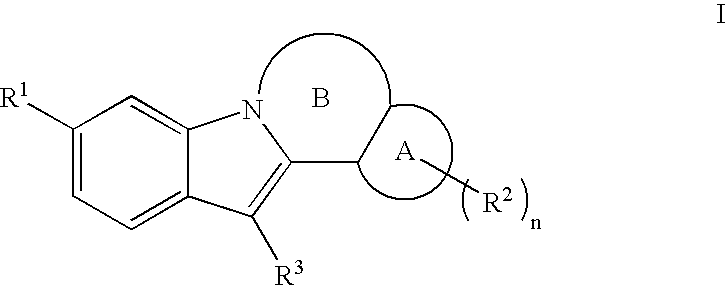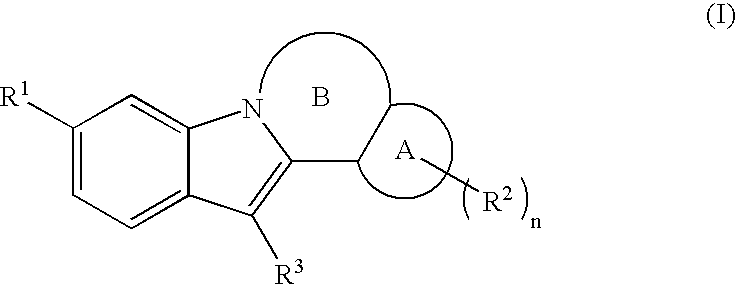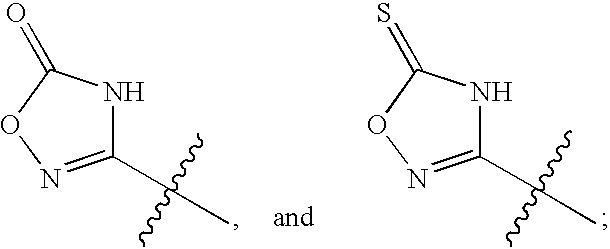Inhibitors of HCV replication
a technology of hcv replication and inhibitors, which is applied in the field of inhibitors of hcv replication, can solve the problems that none of the compounds in the field of hcv replication have progressed beyond clinical trials, and a large fraction of patients do not have sustained reductions in viral load
- Summary
- Abstract
- Description
- Claims
- Application Information
AI Technical Summary
Problems solved by technology
Method used
Image
Examples
example 1
(Compound 9, R2═H) (EC50═C*)
[0242] Methyl 13-cyclohexyl-7H-indolo[2,1-a][2]benzazepine-10-carboxylate. Grubbs 2nd Generation catalyst (85 mg, 0.1 mmol) was added to a solution of Example 8A (800 mg, 2.0 mmol) in 100 mL of dichloromethane under Ar. The mixture was stirred at reflux for 3 hours. After removal of the solvent, the residue was purified by flash column chromatography on silica gel with dichloromethane / hexanes (1:2) to give 520 mg (70%) of the desired product as a colorless solid. ESI-MS m / z 371 (MH+); 1H NMR (500 MHz, CDCl3) δ 0.97-2.11 (m, 10H), 2.86 (m, 1H), 3.95 (m, 3H), 4.21 (s, 1H), 4.91 (s, 1H), 6.29 (m, 1H), 6.82 (d, J=10.38 Hz, 1H), 7.37 (m, 1H), 7.43 (m, 2H), 7.54 (m, 1H), 7.72 (dd, J=8.55, 1.22 Hz, 1H), 7.88 (d, J=8.55 Hz, 1H), 8.15 (s, 1H).
example 2
(Compound 10, R2═H) (IC50=A*, EC50═C*)
[0243] Methyl 13-cyclohexyl-6,7-dihydro-5H-indolo[2,1-a][2]benzazepine-10-carboxylate. Method A: Palladium on carbon (60 mg of 10%) was added to a solution of Example 1 (60 mg, 0.16 mmol) in 60 mL of ethanol and 10 mL of ethyl acetate. The reaction vessel was flushed with H2. The resulting mixture was stirred at room temperature under an atmosphere of hydrogen (balloon pressure) for 4 hours. The mixture was filtered and concentrated to provide the desired product (60 mg, 100% yield) as a colorless solid. ESI-MS m / z 373 (MH+); 1H NMR (500 MHz, CDCl3) δ 1.22 (m, 1H), 1.39 (m, 2H), 1.65 (m, J=12.51 Hz, 1H), 1.76 (d, J=8.85 Hz, 2H), 1.91 (d, J=11.90 Hz, 1H), 1.91 (d, J=11.90 Hz, 1H), 2.06 (m, 3H), 2.38 (m, 1H), 2.56 (m, 1H), 2.68 (dd, J=13.43, 6.71 Hz, 1H), 2.91 (m, 1H), 3.70 (m, 1H), 3.97 (m, 3H), 4.43 (dd, J=14.34, 6.71 Hz, 1H), 7.35 (m, 4H), 7.73 (dd, J=8.54, 1.53 Hz, 1H), 7.87 (d, J=8.54 Hz, 1H), 8.08 (s, 1H).
[0244] Method B: Tetrakis(tripheny...
example 3
(Compound 11, R2═H) (IC50═B*, EC50=E*)
[0245]
[0246] 13-cyclohexyl-6,7-dihydro-5H-indolo[2,1-a][2]benzazepine-10-carboxylic acid. Example 2 (60 mg, 0.16 mmol) was dissolved in a mixture of 1 mL each of THF, methanol, and 1N NaOH. The mixture was microwaved at 100° C. for 10 minutes. After removal of the organic solvents, the mixture was acidified with dilute HCl and the precipitated solid was extracted into ethyl acetate. Removal of the solvent and crystallization of the residue from methanol provided the desired product as a pale yellow solid. 1H NMR (300 MHz, DMSO-d6) δ 1.07-2.10 (m, 10H), 2.34 (m, 2H), 2.60-2.90 (m, 2H), 3.19-3.65 (m, 2H), 4.58 (d, J=8.78 Hz, 1H), 7.41 (m, 4H), 7.60 (m, 1H), 7.86 (d, J=8.42 Hz, 1H), 8.12 (s, 1H), 12.57 (s, 1H).
PUM
| Property | Measurement | Unit |
|---|---|---|
| Current | aaaaa | aaaaa |
| Digital information | aaaaa | aaaaa |
| Time | aaaaa | aaaaa |
Abstract
Description
Claims
Application Information
 Login to View More
Login to View More - R&D
- Intellectual Property
- Life Sciences
- Materials
- Tech Scout
- Unparalleled Data Quality
- Higher Quality Content
- 60% Fewer Hallucinations
Browse by: Latest US Patents, China's latest patents, Technical Efficacy Thesaurus, Application Domain, Technology Topic, Popular Technical Reports.
© 2025 PatSnap. All rights reserved.Legal|Privacy policy|Modern Slavery Act Transparency Statement|Sitemap|About US| Contact US: help@patsnap.com



